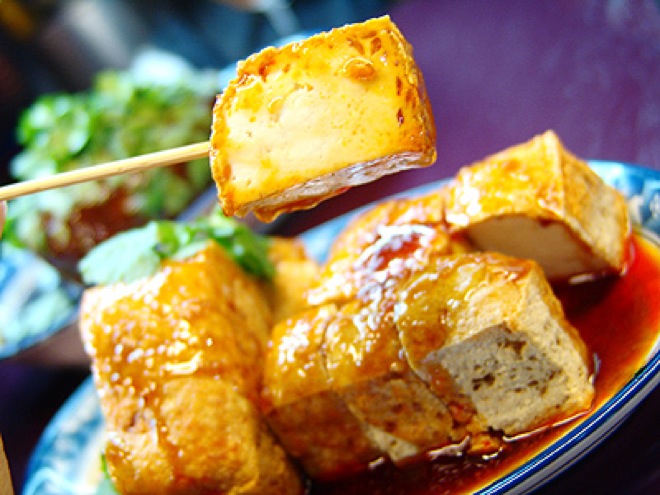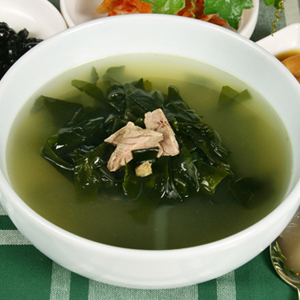By Lola Pak
Illustrations by Sylvia Park
Stinky Tofu
 Asian street carts sell this dish—aged, fermented bean curd soaked in a putrid, inky vat as a midday snack. The marinade can be made from bamboo shoots, herbs and dried shrimp, all perfectly aromatic ingredients—except when it sits in room temperature for 14 days (or more). The smellier, the better, but even when served with a side of chili sauce, it remains doubtful that the rancid bean curd tastes any better than decaying bleu cheese sitting in two-day old garbage.
Asian street carts sell this dish—aged, fermented bean curd soaked in a putrid, inky vat as a midday snack. The marinade can be made from bamboo shoots, herbs and dried shrimp, all perfectly aromatic ingredients—except when it sits in room temperature for 14 days (or more). The smellier, the better, but even when served with a side of chili sauce, it remains doubtful that the rancid bean curd tastes any better than decaying bleu cheese sitting in two-day old garbage.
Chungookjang
 It’s the amino acid breakdown that gives this soybean paste its foot odor-like fragrance. After a few days of fermentation, it turns into a puke-brown/orange-hued mush, which is used for chungookjang jjigae, a thick, salty stew made with onions, potatoes, and greens.
It’s the amino acid breakdown that gives this soybean paste its foot odor-like fragrance. After a few days of fermentation, it turns into a puke-brown/orange-hued mush, which is used for chungookjang jjigae, a thick, salty stew made with onions, potatoes, and greens.
Durian
 The spiky shell should be warning enough. When cracked open, the fleshy, creamy interior emits a scent not unlike gasoline or rotten onions. Mystifyingly dubbed as “the king of fruits” in Malaysia, durian is also abundant in Indonesia, where the stronger the stench, the more expensive. Due to its fetid odor, the oval, tropical fruit also has one thing in common with terrorists and smokers: It’s banned from the Singapore airport.
The spiky shell should be warning enough. When cracked open, the fleshy, creamy interior emits a scent not unlike gasoline or rotten onions. Mystifyingly dubbed as “the king of fruits” in Malaysia, durian is also abundant in Indonesia, where the stronger the stench, the more expensive. Due to its fetid odor, the oval, tropical fruit also has one thing in common with terrorists and smokers: It’s banned from the Singapore airport.
Fermented Skate
 Unless you enjoy breathing in ammonia, avoid skate at all costs. A type of stingray that excretes through its skin, its hellish aroma is caused by uric acid-soaked flesh that has been left out in room temperature for days.
Unless you enjoy breathing in ammonia, avoid skate at all costs. A type of stingray that excretes through its skin, its hellish aroma is caused by uric acid-soaked flesh that has been left out in room temperature for days.
Dried Squid
 Koreans gnaw on dried squid while drinking beer and soju. Too bad the rubbery strands smell like dead mice. But for devotees, the stinky treat reminds them of the beach, where yards of squid commonly hang on clotheslines.
Koreans gnaw on dried squid while drinking beer and soju. Too bad the rubbery strands smell like dead mice. But for devotees, the stinky treat reminds them of the beach, where yards of squid commonly hang on clotheslines.
Natto
 Japanese fermented soybeans are mostly eaten raw, sometimes with scallions and often with rice. A marshmallow-type goo keeps it sticky—and quite frankly, makes it look disgusting. The gluey texture, caused by stirring in soy sauce and mustard, is enough to trigger a gag reflex.
Japanese fermented soybeans are mostly eaten raw, sometimes with scallions and often with rice. A marshmallow-type goo keeps it sticky—and quite frankly, makes it look disgusting. The gluey texture, caused by stirring in soy sauce and mustard, is enough to trigger a gag reflex.
Curry
 It may not be the smelliest, but curry definitely has a signature aroma. Originally from India, other Asian countries have gradually created their own variations of the pungent, spicy sauce, typically made from curry powder, tamarind, garlic and herbs.
It may not be the smelliest, but curry definitely has a signature aroma. Originally from India, other Asian countries have gradually created their own variations of the pungent, spicy sauce, typically made from curry powder, tamarind, garlic and herbs.
Fish sauce
 Made from fermented fish and salt crammed in a jar for a whopping nine months, this brown liquid is drained and left to sun, resulting in the condiment we generously squeeze into our beloved pho. Tip: The hue should be a reddish-brown, like sherry or brandy. If it’s muddy brown, count on a fishier whiff.
Made from fermented fish and salt crammed in a jar for a whopping nine months, this brown liquid is drained and left to sun, resulting in the condiment we generously squeeze into our beloved pho. Tip: The hue should be a reddish-brown, like sherry or brandy. If it’s muddy brown, count on a fishier whiff.
Shrimp paste
 Used in dipping sauces and stews, this is essentially rotten dried shrimp. The salty mash of mini, coral-hued crustaceans with their beady black eyes intact and swirling in brine is a basic ingredient in kitchens in the East. The larger question remains—what’s up with the Asian obsession with rotten, decaying edibles?
Used in dipping sauces and stews, this is essentially rotten dried shrimp. The salty mash of mini, coral-hued crustaceans with their beady black eyes intact and swirling in brine is a basic ingredient in kitchens in the East. The larger question remains—what’s up with the Asian obsession with rotten, decaying edibles?
Dwenjang
 This powerfully fermented soybean paste, which is slathered into lettuce wraps and cooked in stews, is a Korean kitchen staple. Did you know it’s actually decomposing beans and brine? Crushed soybeans are placed into blocks and left to sun for around three months. Then the blocks are shoved into large, stone urns that are placed into the ground to essentially rot away. Delish!
This powerfully fermented soybean paste, which is slathered into lettuce wraps and cooked in stews, is a Korean kitchen staple. Did you know it’s actually decomposing beans and brine? Crushed soybeans are placed into blocks and left to sun for around three months. Then the blocks are shoved into large, stone urns that are placed into the ground to essentially rot away. Delish!






